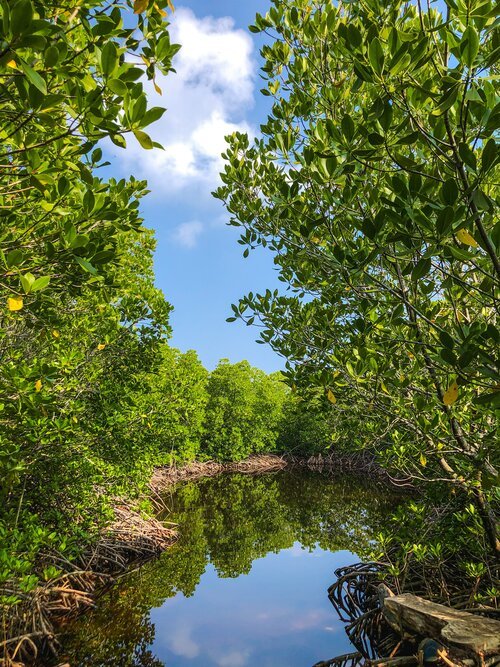Mangrove Deforestation
This month on the Environmental Calendar, we take a closer look at Deforestation. What are the causes, the impacts and the things we can all do to help?
Wildlife & Welfare Researcher, Rose Little, is currently volunteering with Global Vision International (GVI) in Puerto Morelos, Mexico and has written this blog post about deforestation of mangroves in both Mexico and the world.
Mangroves are mysterious places that hold many secrets and unknown creatures. Here in Mexico the mangroves are part of my daily life and I definitely take their important ecosystem services for granted. There are 80 different species of salt-tolerant mangrove trees that have adapted to life in harsh and often exposed coastal conditions. The complex salt filtration and root systems have evolved to cope with immersion in salt water and protect against wave action. The mangrove trees have also adapted to low-oxygen in waterlogged mud. Mangroves are the home to many juvenile fish species and insect larvae. They host an incredible number of species in biodiversity hotspots.
An estimated 80% of the global fish catch relies on mangrove forests either directly or indirectly.
Mangroves are an important natural defence system against coastal erosion, protecting many coastal communities. They stabilize the shoreline, decreasing the damage caused by storm surge, flooding and hurricanes. They also play a key role in maintaining water quality. The dense network of roots and surrounding vegetation allows them to filter and trap many sediments, heavy metals and pollutants protecting the coral reefs and seagrass beds. Without the mangrove systems the coral reef I have grown to love would not exist. Instead they would be smothered with sediments and the water quality would be significantly lower. Conversely the marine ecosystem is so tightly interconnected that without the coral reefs reducing the strength of the waves and currents mangroves would not be able to survive.
Although mangroves account for only 0.7% of the Earth’s tropical forest areas, they are the most productive and important ecosystems in the world. Mangroves have the incredible potential to sequester millions of tons of carbon dioxide from the atmosphere.
A healthy mangrove system can sequester up to 40 times more carbon than the same sized area of rainforest.
Conserving and restoring the mangrove system will be essential in the fight against climate change to which they are highly vulnerable due to rising sea levels.
Intact and healthy mangrove forests have the potential to increase the economic revenue of communities. Sustainable revenue-generating initiatives include ecotourism, sport fishing and other recreational activities. However, when development is unregulated the mangroves are severely threatened. Examples of this include the mega tourism in Mexico and large-scale shrimp aquaculture in many parts of the world.
In the last 20 years over 60% of Myanmar’s mangroves have been deforested primarily due to agriculture, aquaculture and infrastructure development. Also in the last 20 years 95% of mangrove forests in Mexico and up to half of its remaining mangroves may be lost in the next 50 years. This is vastly due to a state-owned oil company, Pemex. Pemex has defied a government order by destroying protected mangrove trees on the site where the Mexican president Andres Manuel Lopez Obrador has ordered the construction of an oil refinery. Satellite imagery has shown destroyed landscape on the site presumably to accommodate the $8 billion controversial project.
Mangroves are particularly threatened by selective logging and conversion to pasture land in the Southern Caribbean. When Mangroves are deforested not only are large amounts of carbon dioxide emitted through uprooting trees but when mangrove soils are above water the much more potent greenhouse gas, methane, is released into the atmosphere. Overall, researchers have suggested that the deforestation of mangroves contributes to 3-19% of global deforestation-caused carbon dioxide emissions. The deforestation of mangroves costs $6 billion to $42 billion every year. The cost does not include any loss of other ecosystem services that mangroves provide, such as flood mitigation and nurseries for fish stocks. There are many specialist species that live in the mangrove systems and some are already considered endangered or critically endangered (see table below). As mangroves are destroyed more of these extremely specialised flora and fauna will not survive the change of habitat. Many other species also rely on the mangrove system for reproduction and breeding. The closely packed mangrove roots protect many juvenile species from predation and other dangers increasing their chances of survival.
The number of discovered and at risk species in mangrove forests. Source: IUCN Red List, 2017
The Global Mangrove Alliance (GMA) brings together experts, governments, local communities and businesses to conserve and restore mangroves with a comprehensive and coordinated approach. Their aim is to reverse the loss of the worldwide mangrove habitats and expand the global extent of mangrove habitats by 20% by 2030. The many partners of the GMA are doing this through restoration projects, education of local communities, research and influencing policy makers.
Restoring mangrove ecosystems can be easily done through replanting mangrove trees. When land ecosystems vegetation is healthy the fauna will soon follow. CINVESTAV (the Center for Research and Advanced Studies of the National Polytechnic Institute) in Mexico have demonstrated that in only 3 years after restoration activities in Ciénaga del Progreso began 53 hectares (48 percent of the total degraded area) is recovering.
You can also protect the mangroves from home by looking for sustainable alternatives to eating farmed shrimp from mangrove areas. Support local conservation efforts and government organisations that are working to conserve mangrove habitats. The marine ecosystem is very fragile and yet provides us with much needed protection from tidal energy and meteorological events as well as providing us with oxygen to breathe. We need to protect these amazing, mysterious ecosystems in order to mitigate climate change and to continue to support and protect the land that we live on.
Please click the link below to visit our Environmental Calendar. Each month we focus on a new environmental topic and look in to how we can all help to improve the world we live in.




